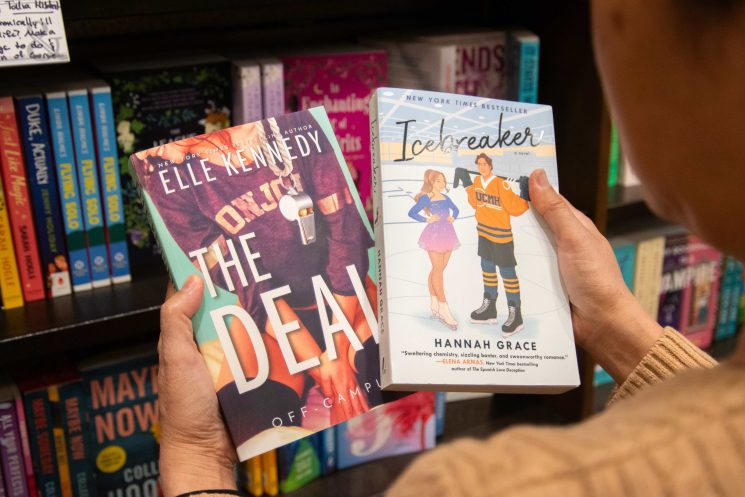
By Jenny Tran
Ah, romance. A genre as old as time. Once in the form of the Romans’ Eros (A.K.A. the god of erotic love) that morphed into Shakespeare’s tragedies (“Wherefore art thou Romeo?”) that ultimately culminated into early-2000s vampire and werewolf heartthrobs (“Twilight”).
And no, it doesn’t end there. Because people change, and so do their tastes, and before you know it, the next shiny, big new thing is hurtling at you without prior warning or even sensical reason. And you just accept it, this new obsession forming in an already convoluted and messy genre.
Which lately has been … hockey?
Quick warm-up
If you haven’t been keeping up with the online book space lately — or you just, like, don’t read — you might be a little lost at the correlation here. Understandably.
Hopefully, you have a vague idea of the sport of hockey itself, though. (If not, to summarize: stick hits puck, the puck goes into the net.)
Or, maybe you don’t. This is also understandable, considering that the National Hockey League (NHL) has the smallest following among the four major sports leagues in the US. For a variety of reasons dating all the way back to the multi-faceted origins of hockey. (To summarize, it’s mostly Canada’s fault.)
So people don’t watch hockey as much as basketball or American football. Nothing wrong with that.
Except maybe for the fact that despite the sport’s comparably measly viewership, it practically dominates Amazon’s list of top sports romances. Because that makes perfect sense.
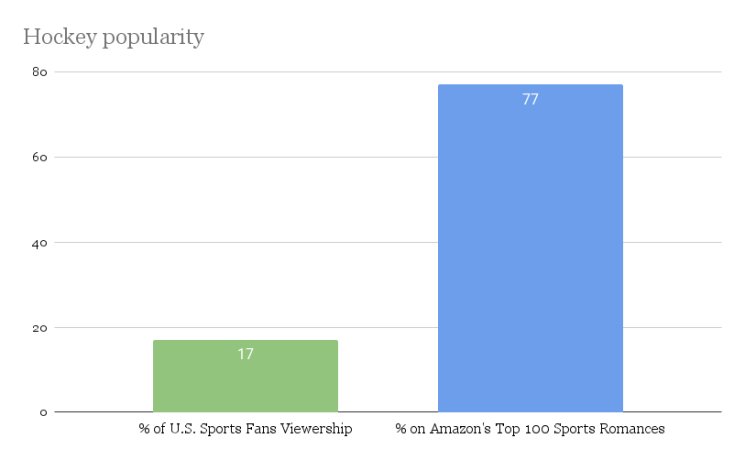
Actually, according to the numbers, it doesn’t. So, what’s the deal with this insane paradox? Why are people suddenly so obsessed with this particular subgenre? Why has it gotten so bad that I’m typing up a whole analysis about it instead of doing my stats homework?
First things first. Let’s address the elephant in the room.
Puck drops and BookTok
You know what TikTok is. And maybe you’re familiar with a certain, very densely populated corner of the app: BookTok.
A magical world of Colleen Hoover collections and shirtless face claims and a never-ending supply of promising novel recommendations. A dream, really.
Especially, especially, if you’re into romance novels, which have basically, unabashedly, swarmed the space. And these devoted readers haven’t let this subcategory slip (skate?) by. A few seconds of scrolling on the #romancebookrecs tag will have you stumbling upon at least one book with a stick or puck on the cover.
Of course, the idea of TikTok catapulting books, both new and old, to unbelievable levels of fame has been around for years now. It’s marketing; it’s a pyramid scheme; it’s Jane Austen’s plan to bring back classics. Whatever it is, it works.
This case, though, is more than just one book (see: “Fourth Wing”). It’s a whole, oddly specific sub-genre of them.
Now, I’m not saying BookTok is the sole benefactor to the hockey-romance success story. Just that it’s a likely catalyst, particularly after a messy scandal involving a real NHL player and the public sexualization of him by BookTok creators a few months ago, which caught the attention of more than a couple of curious eyes.
The real question I’m trying to tackle here is this: what’s so compelling about hockey romances that led to its popularity in the first place?
Well, after a bit of research and a lot of psychoanalyzing, I’ve gathered several theories of my own. And while these may not directly answer the question at hand, they can allude to likely reasons for this enigma.
Theory #1: Ignorance is bliss
Okay, yeah, there’s a bit of irony here. But hear me out.
Think of hockey as, like, the mysterious bad boy. You’re aware of his existence and pass him in the hallways. You’ve heard things about him, but have never actually spoken to him. Still, you can’t quell the inkling of curiosity about what lies beneath the rubble of rumors, of the real human under the mask.
And that, the art of not knowing, is what draws you to him. There’s a certain allure to a good mystery, of unraveling a whole new world you’ve never seen before.
Matter of fact, a good lot of romance readers have never watched, let alone played a game of hockey in their lives. But, you don’t need to be an expert to read about it, especially with genres as accessible as romance. A lot of the learning about the game can even come from the reading itself.
What you don’t know about hockey is exactly what intrigues you in the first place. So, there’s sorta an inverse relationship here.
Theory #2: Tropes galore
What does hockey actually entail? Someone who plays it might have a more technical response. But as a romance reader, let’s just say that the rink is a breeding ground for a lot of popular tropes. And I mean a lot.
As the Washington Post puts it, “romance novels rely on tropes.” Not completely, but they’re usually important elements, especially to draw in readers. You might not expect it, but many aspects of hockey just so conveniently offer ways to implement said tropes.
Enemies-to-lovers? Rival teams, easy. Found family? We’ve got a whole team of them, forwards and wingers alike. Secret relationship? I don’t know why you want to hide that you’re dating an NHL player, but I don’t make the rules here.
Not to mention that hockey is the only major American sport that allows fighting. Imagine: character A tending to character B’s wounds, after B so chivalrously attacked evil antagonist C for A. There’s a blood-soaked vision there.
For a team-based, fast-paced sport, the inherent dynamics of it all just play out so well. Do you want drama and high stakes? That’s basically hockey’s middle name.
Theory #3: Smut > sport
Yeah. Self-explanatory. It’s really no coincidence that virtually all popular hockey romance books as of late carry some sort of explicit sexual themes. And for a lot of them, the sex takes quite a lot of the pages. To the point where the book wouldn’t even classify as a novella if all the smut was taken out.
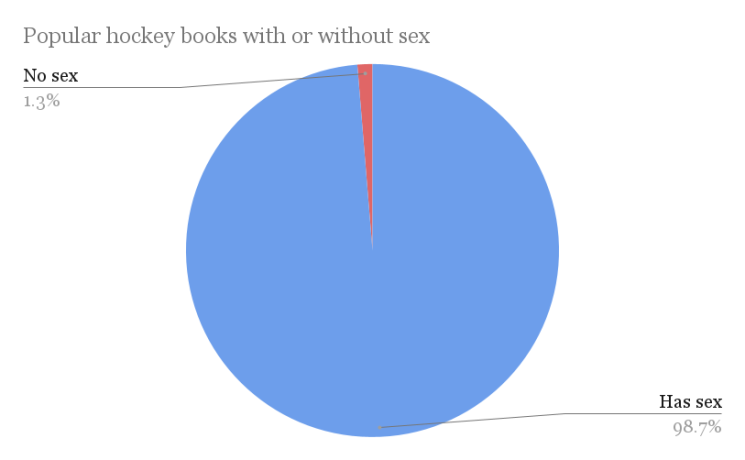
Here’s a book whose title you’ve probably heard thrown around a bunch, one that’s been tightly associated with the sub-genre as a whole. “Icebreaker” by Hannah Grace may as well be the face of hockey romances, given that it’s now spent 61 weeks on the New York Times Fiction Bestsellers list, and given that everyone asks me if I’ve read it yet. (The answer is still “Uhhh, no.”)
A few friends of mine, whom I for now will not disclose the names of, have taken the liberty to read “Icebreaker” on their own accord. And their descriptions were simply put: all sex, no plot. Maybe a little exaggerated, but you get the idea.
But, come on. It has to have taken the #1 spot for multiple weeks in a row (multiple times) for a reason; it’s nestled in between dense fantasies and mind-twisting thrillers, which are well-known for their carefully pieced-together plots. Not that I’m saying hockey novels inherently lack plot, just that they definitely do not lack the sexy time.
And maybe that’s what makes them so addicting. There’s no denying that pornography, every and any form of it, can be addicting. And some people appear to seek their pleasure in the form of phrases like “I’m nothing but a net for him to shoot at.”
Perhaps it isn’t the plot, then, that keeps readers hooked. Perhaps, if you keep the “p” and replace the “-lot” with “-orn,” it’s enough to keep them turning the pages. If you know what I mean.
Theory #4: Power plays, but the good kind
Some technical jargon in case you didn’t know: a power play happens when a team has a number advantage, typically when a player from the opposing team commits a penalty and is sent to the sin bin. A good thing for one side, obviously; a bad thing for the other.
Hockey romances, though? They’re great for everyone. For the entirety of society, actually — and not just because of the smut, surprisingly enough.
For readers, fiction is often a means of escape. In this case, that would be from the real-life toxicity of hockey culture. As of recent news, there have been revelations the sport’s national governing body Hockey Canada had secretly paid millions of dollars to settle sexual assault cases without court hearings or proper investigation. This is, of course, a blaring red flag — but it’s not just the higher-ups who have underlying issues.
Tim Skuce, an associate professor at Brandon University and prior elite hockey player, still remembers the “misogynistic comments, homophobic slurs, notions about hypermasculinity [and] manning up” in the 1970s and 80s. Decades later, 15-year-old Blake Holtsbaum recalls bouts of hazing and “cage rages” among his teammates, as well as comments blatantly demeaning and objectifying women.
“It made me completely hate coming to the rink,” Holtsbaum said later on. “I felt it was an environment where people just get hurt.”
While toxicity in sports isn’t a new thing, that doesn’t make it a good thing either. And hockey in particular still has a long way to go in dismantling all the inherently abusive habits it’s built up over the years.
But, it doesn’t hurt to try. To, dare I say, hope. And when you read stories about underdogs fighting against the odds and not caring about what other people think, you can’t help but feel a little good inside. This fictional world is just within reach, where players are actively critical of the bad parts of hockey, where harassment and insensitive comments are being snuffed out of the locker room. Where even queer love stories can exist in historically heterosexual and non-inclusive spaces. (My favorites, by the way.)
It’s cheesy, sure, but it works. People don’t escape to novels to read about their current world, but usually a different one. A better one. One that makes them feel that change is still possible. Which apparently includes hockey.
Except, well …
Theory #5: They’re all white
Okay, not all. But close enough, since 84% of the NHL’s workforce, including players, coaches and staff, are white. And as of 2022, racial minorities only make up 7% of the league, making it the whitest pro sport in the U.S. And I’m not just saying that to be funny.
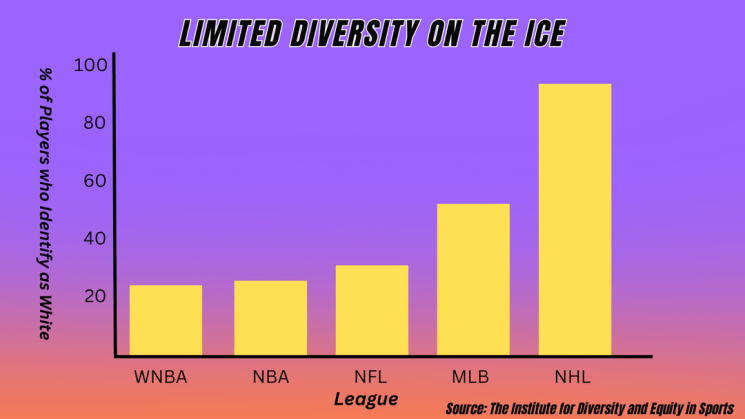
Ever since the creation of the NHL, hockey has been a predominantly white sport. This is due to a combination of economic and sociological factors, including the early lack of diversity in the populations that tied on their skates first. (Again, Canada’s fault.)
I’m not going to get into the why right now, just the what. And the facts are this: no matter how different other aspects of hockey novels are from real life, one aspect almost always remains the same. As in, the characters are white.
Not the entire cast, of course, but mostly always the main two protagonists. Such is obvious already by looking at the covers of the most popular hockey romances. Yes, including the beloved “Icebreaker.”
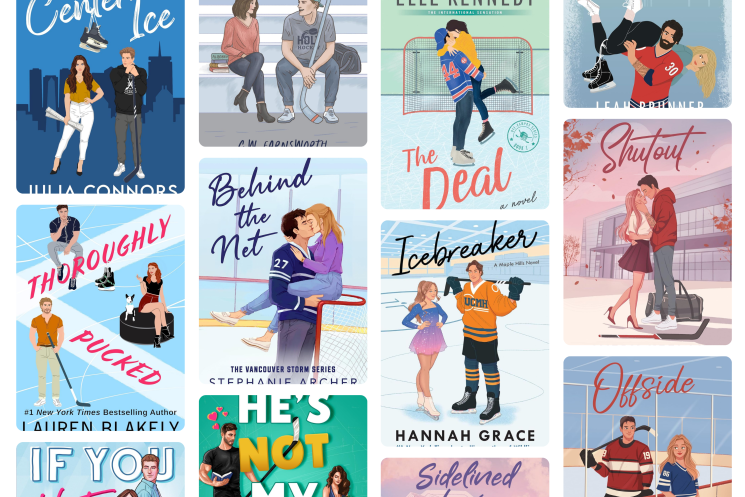
Now, I’m not saying people have intentionally malicious or even racist intentions when choosing their next read. I have to admit that out of the dozen hockey romances I’ve read myself, the only non-fully-white main character is Shane Hollander from “Heated Rivalry,” who’s half-Japanese and my best friend.
Most of the time though, it’s not really the fault of the reader, but rather the already inherent white-ness of romance literature. And simply, literature itself, as well as the publishing industry. From a study done by the New York Times on prolific publishing houses, “of the 7,124 books for which [they] identified the author’s race, 95 percent were written by white people.”
Not only does it help to be white if you want to be published, but it also helps to get your books read if your characters are white too. Because, and this might be a hard pill to swallow, white literature is just easier. One novelist says it plainly: “Fiction written by and about people of color is often political, and the work itself becomes about the characters’ identities as minorities.” Obviously, this varies, and not everyone defaults to such judgment. But it still happens, even accidentally, especially when someone is just looking for some quick entertainment and not a mind wrangler.
Again, I wouldn’t say that the readers themselves are to blame. Just like the complex issues of hockey, internal biases you’ve had all your life — in my experience, from seeing primarily white people in all types of media — are hard to get rid of. It takes a lot of self-reflection and patience, as well as time, to eliminate these sorts of instincts. And maybe you don’t even notice yourself gravitating toward books with white people brandishing hockey sticks on them, just like you don’t notice yourself seeking out white TV shows and YouTube videos and video edits of celebrities. At least not intentionally.
It’s just unfortunate that hockey’s fundamental lack of diversity can easily feed off these biases; romance books merely perpetuate it. There’s this endless cycle where no one’s winning, but no one is trying hard enough to beat the game either. And this is an issue that extends far past the hockey rink. Hockey literature, it seems, is just another casualty of decades of internalized (and externalized) racism.
But, hey, you don’t win a Stanley Cup overnight. For now, all you can do as both a reader and person is to be self-aware, as well as remain careful not to completely disregard underlying problems for the sake of your own enjoyment and comfortability. And this goes for a lot of things beyond the scope of fiction.
Going into overtime
Last winter break, my friend invited me to watch the Anaheim Ducks play against Seattle with her family. It was the first time I’d ever seen a professional sports game in real life, let alone an NHL game, so I was psyched. Let’s just say hockey books have gotten me a little too invested in the affairs of professional hockey.
It was an enlightening experience; I was a little dazed the entire time. And, fine, I was also swooning a little over the good-looking players. A fork was found in a kitchen.
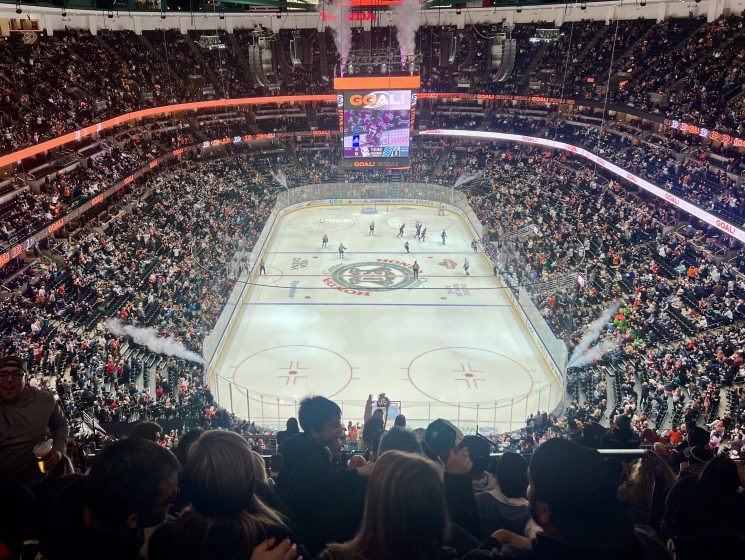
But it’s funny how I got there, sitting in that stadium surrounded by other hockey fans, whose histories don’t align with mine at all. While I had been into hockey for maybe two months at the time, there were people sitting near me — at least based on their raucous screams — who sounded like they had been die-hard Duck fans their entire lives, for reasons I can’t even begin to guess.
The point I’m trying to make is that no two journeys are the same. There are so many different ways to enjoy one thing, and none of them are necessarily wrong. Classes like AP Literature exist for a reason. One, to fail me. And two, to stress the sheer complexities of literature, of how there are endless interpretations for one piece of art.
As Socrates had sort of said: “I know that I know nothing.” And all the theories I discussed above are just that — theories. There’s no concrete reason to explain why people flock to hockey like moths to a flame. For one person, it could be a combination of different factors; for another, it could be because of the smut. Both are equally valid.
So, honestly, just enjoy the books you like, for reasons you don’t have to look too hard into. And, for the love of God, don’t judge other people for their literary tastes. Or bother hot hockey players without their consent.
And if you need any book recommendations? Hit me up. (Unless you’re Jack Hughes. Then hit me up any time.)





